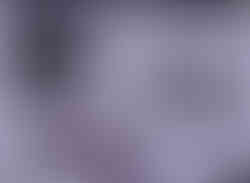Assignment two: Stitching: Placed and spaced
- Juliet
- Feb 22, 2019
- 4 min read
Updated: Feb 28, 2019
Explore the creation of a series or small collection of stitched textiles inspired and informed by your drawings and your stitched paper explorations, showing a sense of repetition, variety of scale, a placement design.
Started by reviewing drawing folio from Part One, paper manipulation library and paper stitched pieces from Part Two.
I decide to return to one of my earlier mark-making pieces and examine it more closely:
I returned to my sketchbook to explore possible different directions:
I choose an area to isolate and focus on, using a cardboard viewfinder. Looking closely at the effect of the white ink on the black paper, I draw it and create a collage from it using different papers and fabrics: translucent greaseproof paper, a fabric/paper hybrid that is used in packaging and translucent plastic sheeting that is found in cereal packets.
I find the idea of stitching white onto black quite exciting and think I might experiment with alternating white onto black and black onto white to see what different effects are achievable.
Inspired by the work of Kirsty Whitlock I also decide to experiment with heat and plastic and layers. I also think I will return to collage as a drawing technique in order to explore the qualities of my drawings and take them off in another direction, hoping this will lend itself to further interpretation in stitch.
I use a translucent plastic sheet that I have ironed under greaseproof paper to cause sections of it to melt, creating a raised texture, reminiscent of bubbles. I decide to use this in my collage to help create different textures and layers in my interpretation of the original white on black paper printing. Here I try to pay attention to the placement of the design on the matt black background, the sense of scale that I have enlarged from the original.
I use an enlarged scan of my original collage to increase the scale and to get the sense of repetition that are key for this assignment:

This process exaggerates and enhances the qualities of the papers used in the collage, enhancing the shadows, forms and contrasts in the materials used, making it clearer to me how to translate this into fabric and stitch. I am still experimenting here with different materials and background materials, here trying layers of grey and white felt on white muslin:
I explore the right fabrics to help me translate the textures in my paper collage and settle on a matt black polyester/cotton fabric as base fabric, a grey woollen felt that seem to evoke the qualities of the greaseproof paper as seen in the scanned version of the collage :
, on top of which is layered white muslin which has been stitched to move the warp and weft of the fabric to create texture, and a top layer of grey polyester with a sheen, which has been
I like the loose connection of the shapes on the fabric: they are similar rounded rectangular shapes but are all slightly different. They are loosely connected but not touching, following a line but not a straight one.
I haven't really exploited the aspect of developing the base textile in this piece though. I have learnt a way to reinterpret my own drawing to take a piece in a different direction, as I did this with the collage, before moving into stitching. I have also learnt to look more closely at my own drawing in order to do this to examine the effects of the ink on the paper.
This leads me to thinking about my second stitched textile work, using this first piece as a starting point.
I return to one of the samples developed for Exercise 2.4, which took the same drawing as a starting point:
Sketches thinking about placement and repetition and considering how I could interpret this in a different way:
My aim here is to create the shades of grey using fabrics which range from matte to shiny, black to white and lots of shades of grey in between. Contrasting fabric weights from light and floaty nylon netting used as a backing material to heavy matte black denim, variety of shades and textures in fabrics used as appliqué layered on top of each other and finally machine stitching into the top layer:
This forms into a kind of vertical wall hanging, with the almost invisible base fabric of the connecting the individual pieces of embroidered denim.
Method for this: same base layer of black polycotton, with layers of fabric cut in strips and vaguely triangular shapes, machine appliqued, layer of machine embroidery over the top, spirals to evoke the tidemark-like marks left by the ink on the black paper and the shell-like forms this inspired.
Elements are placed with gaps between; detail showing fabric layering and machine embroidery to evoke the earlier stitched sample:
For my third piece I wanted to bring together elements from more than one earlier piece of work and think more closely about transforming the base textile.
More sketchbook explorations:
Progression from initial sketch of rope, detailed sketch thinking about ways of stitching this, crumpled and glued paper layering, simplified sketch, black stitching on crumpled paper, crumpled muslin fabric glued to plain white cotton backing fabric, stitching into this crumpled fabric using two thicknesses of thread to (thick: black necklace cord, black linen thread):
The stitches are careful;y placed to include areas of white space in between them. The scale of the stitch has been increased from the paper stitched sample and there is a repetition in the groups of three of four stitches and the way they are placed at angles to each other.
These are the sketches and samples that informed this stitched piece:

My final three pieces:


































































































Comments